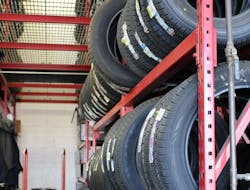This MTD exclusive - provided by Mike Ryan, a supply chain executive with 25-plus years of experience, including nearly 10 with a major tire manufacturer - is the latest in MTD’s 2022 Tire Dealer Survival Guide series. Stay tuned to www.moderntiredealer.com for additional Tire Dealer Survival Guide articles.
Your inventory is a lot like one of the maxims from the “Goldilocks and Three Bears” fairy tale. “Too much” stock and you run out of cash. “Too little” inventory and you can lose sales.
Inventory is like a shock absorber against changes in demand. Having “just enough” of the right product at the right time for your customers is a crucial component of success.
However, if you don’t have enough stock, you risk customers going somewhere else. Stock too much product and you tie up cash that your business could use for sales and marketing or other investments.
Inventory also is an investment. To some degree, each tire is like cash in the bank. Sell a tire and you get cash. But every tire that sits and gathers dust is like having hundreds of dollars of cash “frozen” in inventory. You can’t grab a tire, bring it to the grocery store and use it to buy a loaf of bread.
So what does this mean for you? Over the years, the tire supply chain has evolved to have inventory buffers at manufacturers and wholesale distributors in place that allow them to meet the needs of tire dealers. These inventory buffers help dealers replenish the stock of fast-moving products, while holding specialty SKUs - which tend to be slower moving - at centralized locations.
Manufacturers forecast demand for each SKU and determine how many are needed. This demand forecast sets stocking levels across the wholesale distribution network. If you’re a retailer, having solid relationships with wholesale distributors can help you determine what a product assortment that covers 90% of your sales should contain.
The challenge of complexity
Multiple manufacturers have multiple options for most tires, which quickly creates complexity for wholesalers and retailers.
With literally thousands of tire SKUs available, it can be a daily challenge to maintain the right inventory assortment for a location.
Each location has a unique customer base. A tire store in Akron, Ohio, will stock a different assortment than a tire store in Anaheim, Calif. Unfortunately, there isn’t a magic wand that gives us a one-size-fits-all assortment.
This is why information needs to flow along the supply chain to serve your customers best, while maximizing your cash flow. Taking a market-back approach - from your business to your wholesale distributor and up the chain to the tire manufacturer - means that communication needs to be data-driven and actionable.
What to track
Your inventory should reflect the products that move in your market. Each location should track sizes, quantities and brands of tires sold. Recording sales and lost opportunities daily will allow you to refine your product mix over time.
Periodically - at least monthly - data on sales and lost opportunities should be collected and reviewed. By looking at the data and comparing it to your inventory assortment, you can identify gaps in your portfolio.
One of the best - albeit most painful - ways to check inventory is to look back and see how many sales were lost because you didn’t have a tire in stock.
Completed sales versus lost sales will determine your fill rate. For example, if your retail location had - or could get - a tire that was needed 529 times within the last month and couldn’t get it 47 times within the last month, your ll rate would be 92%, using this calculation: 529/(529 + 47) = 92%.
Looking at which tire sizes are not moving can indicate the need to refresh your assortment. For example, if you regularly stock 100 SKUs and have sold 90 of the 100 within the past month, your inventory is 90% healthy. If instead you sold 35 of the 100 SKUs, your inventory is 35% healthy.
Managing turns
Measuring the health of your inventory is an indicator of how well your product assortment meets the needs of your market. Inventory turns measure how quickly or slowly a product is being sold. For example, if your inventory turns four times a year, it means, on average, it sits for 91 days (365 days divided by four = 91 days.)
To calculate inventory turns, you need two pieces of information:
1. Annual cost of goods sold (COGS), and;
2. Average monthly inventory
Divide COGS by your average monthly inventory to determine turns. In general, the higher the number, the better the business performance. Improving inventory turns by actively managing the SKUs you hold will improve cash flow.
Here are four actions you can take today:
1. Determine your fill rate;
2. Measure the health of your inventory;
3. Calculate your inventory turns, and;
4. Ask your wholesale distributor for help.
Someone once said, “The definition of insanity is doing the same thing over and over again and expecting a different result.” Therefore, to improve the performance of your inventory, you must actively monitor its performance and adjust the mix as necessary.
At a minimum, you should review your stock mix at least once a year. Your wholesale distributor can support the review process and it’s a great way to create a win-win for both your customers and your business.
Mike Ryan is a supply chain executive with 25-plus years of industry experience. He quickly breaks down complex issues and identifies actions to generate cash and improve profitability. Before starting his firm, Mike spent eight years with Goodyear Tire & Rubber Co., where he helped lead an advantaged supply chain transformation in implementing sales and operations planning. For more information, email Ryan at [email protected]
Past Tire Dealer Survival Guide articles:
